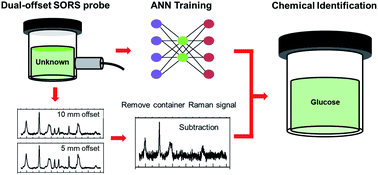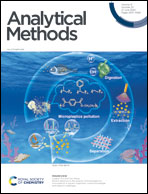In situ real-time identification of packaged chemicals using a dual-offset optical probe†
Abstract
In situ real-time and nondestructive identification of packaged chemicals is essential for applications such as homeland security and terrorism prevention. Although various Raman spectroscopic methods such as spatially offset Raman spectroscopy (SORS) and time-resolved Raman spectroscopy have been investigated for real-time detection, the background interference originating from packaging materials limits the accuracy of the analysis. In principle, the Raman background from the packaging cannot be removed completely. To overcome this limitation, we developed a SORS-based dual-offset optical probe (DOOP) system that offers real-time prediction of 20 chemicals concealed in various containers by completely removing the background signal. The DOOP system selectively acquires the Raman photons generated from both the outer packaging and the inner contents, whose intensities are dependent on the penetration depth of the laser. The Raman spectra obtained at two remote offsets are automatically subtracted after normalization. We demonstrate that the DOOP method provides the pure component spectra by completely removing background interference from three plastic containers for a total of 20 samples in three different containers. In addition, an artificial neural network (ANN) was applied to evaluate the accuracy of the real-time chemical identification system; our system led to drastic improvements of the ANN prediction accuracy.



 Please wait while we load your content...
Please wait while we load your content...